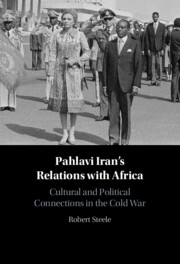Book contents
- Pahlavi Iran’s Relations with Africa
- Pahlavi Iran’s Relations with Africa
- Copyright page
- Contents
- Figures
- Acknowledgements
- Note on Transliteration
- Introduction
- Part I Establishing Relations (c. 1957–1970)
- Part II Forming an Africa Policy (1971–1975)
- 5 North Africa, Islam and the Great Civilisation
- 6 Trouble in the Horn and Soviet Encroachment
- 7 Iran and West Africa
- 8 Distributing the Oil Wealth
- Part III Africa and Pahlavi Iran’s Grand Strategy (1976–1979)
- Conclusion
- References
- Index
7 - Iran and West Africa
from Part II - Forming an Africa Policy (1971–1975)
Published online by Cambridge University Press: aN Invalid Date NaN
- Pahlavi Iran’s Relations with Africa
- Pahlavi Iran’s Relations with Africa
- Copyright page
- Contents
- Figures
- Acknowledgements
- Note on Transliteration
- Introduction
- Part I Establishing Relations (c. 1957–1970)
- Part II Forming an Africa Policy (1971–1975)
- 5 North Africa, Islam and the Great Civilisation
- 6 Trouble in the Horn and Soviet Encroachment
- 7 Iran and West Africa
- 8 Distributing the Oil Wealth
- Part III Africa and Pahlavi Iran’s Grand Strategy (1976–1979)
- Conclusion
- References
- Index
Summary
The chapter explores Iran’s policy in West Africa through two very different relationships; those with Senegal and Nigeria. Senegal was identified early in the 1970s as a country that Iran would pursue a special relationship with. This political partnership was facilitated by the strong personal bonds developed between the two sets of leaders, which were shaped by their francophone backgrounds. The president of Senegal, Léopold Sédar Senghor, in particular, shared a close bond with Empress Farah Pahlavi, and spoke eloquently about the inherent similarities between his philosophy of Négritude and Iran’s Iranité. On the other hand, Iran’s relationship with Nigeria was very pragmatic. Iran’s ambassador there, Shāhrokh Firuz, found himself frustrated by the rigidity of Iran’s policy, and the lack of freedom he had to explore new opportunities for Iran, not only in Nigeria, but also other countries in the region. These two relationships provide fascinating insights into Iran’s strategy in arguably the only part of Africa in which it had no immediately obvious security or strategic interests. The chapter explores what drove these relationships, and what each side gained from them.
- Type
- Chapter
- Information
- Pahlavi Iran's Relations with AfricaCultural and Political Connections in the Cold War, pp. 175 - 202Publisher: Cambridge University PressPrint publication year: 2024



